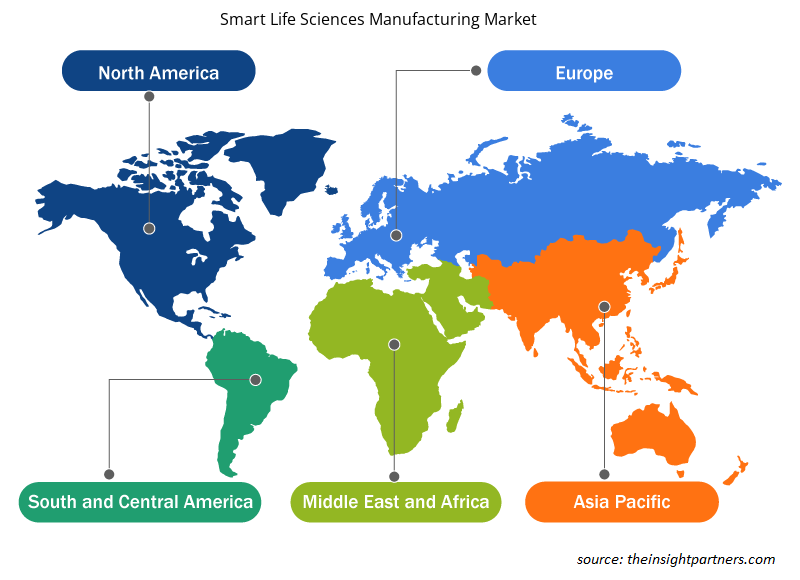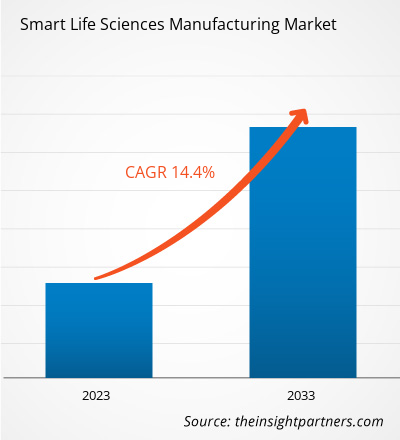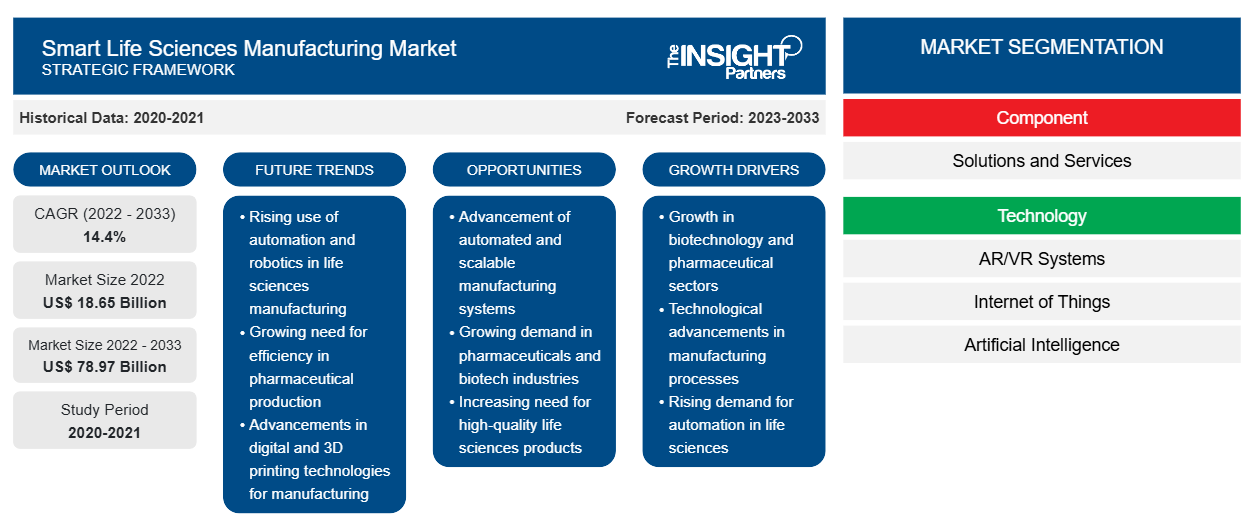Si prevede che il mercato della produzione di scienze della vita intelligenti raggiungerà i 78.974,61 milioni di dollari entro il 2033, rispetto ai 18.649,50 milioni di dollari del 2022; si prevede che registrerà un CAGR del 14,4% nel periodo 2023-2033.
Il processo di produzione delle scienze della vita è cambiato in modo significativo negli ultimi dieci anni. La produzione delle scienze della vita è un processo complesso. Un concetto di fabbrica intelligente che interconnette macchinari e sistemi nel sito di produzione può semplificare il processo di produzione. Il sistema è anche collegato al cliente, al partner e al sito di produzione. Dopo la pandemia di COVID-19, molti produttori di farmaci e dispositivi medici hanno iniziato ad adottare Pharma 4.0, in particolare a causa delle crescenti normative e preoccupazioni in materia di ispezioni. La produzione intelligente delle scienze della vita, spesso nota come Pharma 4.0, mira a fornire una guida pratica, incorporare le migliori pratiche normative e accelerare le trasformazioni Pharma 4.0. L'obiettivo principale è consentire alle organizzazioni che partecipano al ciclo di vita del prodotto farmaceutico di controllare il pieno potenziale della digitalizzazione e fornire innovazioni terapeutiche più rapide e processi di produzione migliorati a vantaggio degli utenti finali. Questi cambiamenti porteranno enormi opportunità ai produttori di scienze della vita negli anni a venire. I moderni strumenti di analisi dei dati hanno consentito ai ricercatori di biotecnologia di creare modelli di analisi predittiva e comprendere i modi più efficaci per raggiungere i propri obiettivi. Big data, intelligenza artificiale, realtà virtuale, visualizzazione dei dati e sicurezza dei dati sono tra le tecnologie comuni utilizzate nei laboratori di biotecnologia. Si prevede che tali fattori incrementeranno notevolmente le dimensioni del mercato della produzione di tecnologie intelligenti per la vita nei prossimi anni.
Mercato manifatturiero delle scienze della vita intelligenti -
Personalizza questo report in base alle tue esigenze
Riceverai la personalizzazione gratuita di qualsiasi report, comprese parti di questo report, o analisi a livello nazionale, pacchetto dati Excel, oltre a usufruire di grandi offerte e sconti per start-up e università
-
Scopri le principali tendenze di mercato in questo rapporto.Questo campione GRATUITO includerà analisi di dati che spaziano dalle tendenze di mercato alle stime e alle previsioni.
Approfondimenti di mercato – Mercato manifatturiero delle scienze della vita intelligenti
Il segmento farmaceutico è un fattore chiave per il settore industriale globale. Inoltre, la domanda e le vendite di medicinali aumentano ogni giorno. Pertanto, le aziende manifatturiere farmaceutiche investono enormi quantità di risorse economiche in R&S per portare innovazioni sui mercati. Gli aggiornamenti tecnologici sono la chiave per affrontare i futuri problemi di produzione. Con questo, il mercato Pharma 4.0 sta guadagnando un'enorme attenzione in tutto il mondo. A giugno 2022, GSK, una Big Pharma britannica, ha inaugurato il suo nuovo impianto di produzione intelligente asettico a Barnard Castle, in Inghilterra. Questo impianto completamente automatizzato sfrutta la digitalizzazione per semplificare il processo di produzione. Ciò, a sua volta, consentirebbe a GSK di accelerare il lancio di nuovi medicinali riducendo al contempo gli sprechi. A dicembre 2020, Bayer AG ha annunciato il lancio di una piattaforma di terapia cellulare e genica all'interno della sua divisione farmaceutica. Questa piattaforma combinerà più funzioni di base per fornire supporto lungo l'intera catena del valore della ricerca e sviluppo di terapie cellulari e geniche . A novembre 2020, il Regno Unito ha iniziato a costruire una "fabbrica del futuro" per rinnovare la produzione di farmaci a piccole molecole. Si prevede che i produttori di farmaci, gli istituti accademici, gli operatori sanitari e gli enti regolatori si riuniranno presso la struttura per testare e migliorare le nuove tecnologie, tra cui la produzione continua, digitale e autonoma. Pertanto, si prevede che la crescente adozione della trasformazione digitale aumenterà le dimensioni del mercato della produzione di scienze della vita intelligenti.
Approfondimenti basati sui componenti
Il mercato della produzione di scienze biologiche intelligenti, per componente, è diviso in soluzioni e servizi. Si prevede che il segmento delle soluzioni manterrà una quota di mercato della produzione di scienze biologiche intelligenti maggiore durante il periodo di previsione, nonostante registri tassi di crescita più lenti rispetto al segmento dei servizi. L'industria farmaceutica sta rapidamente adottando la trasformazione digitale poiché la digitalizzazione apporta flessibilità ed efficienza ai processi. Con la crescente complessità dei sistemi e dei processi di produzione, stabilire l'interconnettività e implementare soluzioni di fabbrica intelligenti robuste in linea con le buone pratiche di fabbricazione (GMP) sono diventate una priorità strategica per le aziende di scienze biologiche. Inoltre, l'Industria 4.0 ha semplificato il processo di accesso ai dati operativi, oltre a consentire alle aziende di soddisfare indicatori chiave di prestazione (KPI) mirati. Le soluzioni di produzione intelligenti aiutano nella gestione della qualità monitorando la temperatura e l'umidità dell'inventario, monitorando la visibilità del processo end-to-end, migliorando la coerenza del prodotto e identificando problemi specifici relativi alla produzione in lotti. L'industria delle scienze biologiche è impegnata nello sviluppo di trattamenti nuovi, efficaci, di qualità e precisi. I pionieri del settore stanno esplorando nuove aree e approcci terapeutici sfruttando gli ultimi progressi tecnologici per ottenere un vantaggio competitivo. Tali fattori determinano la crescita del mercato della produzione di scienze della vita intelligenti per il segmento delle soluzioni.
Il mercato della produzione di scienze della vita intelligenti è segmentato in base a componenti, tecnologia e applicazione. In base ai componenti, il mercato è suddiviso in soluzioni e servizi. In base alla tecnologia, il mercato della produzione di scienze della vita intelligenti è segmentato in sistemi di realtà aumentata/realtà virtuale (AR/VR), Internet of Things (IoT) , intelligenza artificiale (AI), sicurezza informatica, big data e altri. Il segmento IoT ha dominato la quota di mercato della produzione di scienze della vita intelligenti più grande nel 2022. In base all'applicazione, il mercato della produzione di scienze della vita intelligenti è segmentato in farmaceutica, bio-farmaceutica e dispositivi medici. In base alla geografia, il mercato della produzione di scienze della vita intelligenti è segmentato principalmente in Nord America, Europa, Asia Pacifico (APAC), Medio Oriente e Africa (MEA) e Sud America (SAM). ABB Ltd, Bosch Rexroth AG, Emerson Electric Co, Fortinet Inc, General Electric Co, Honeywell International Inc, IBM Corporation, Rockwell Automation, Siemens AG e Sophos Group plc sono tra i principali attori del mercato della produzione di scienze della vita intelligenti.
Approfondimenti regionali sul mercato manifatturiero delle scienze della vita intelligenti
Le tendenze regionali e i fattori che influenzano il mercato Smart Life Sciences Manufacturing durante il periodo di previsione sono stati ampiamente spiegati dagli analisti di Insight Partners. Questa sezione discute anche i segmenti e la geografia del mercato Smart Life Sciences Manufacturing in Nord America, Europa, Asia Pacifico, Medio Oriente e Africa e America meridionale e centrale.

- Ottieni i dati specifici regionali per il mercato della produzione di scienze della vita intelligenti
Ambito del rapporto di mercato sulla produzione di scienze della vita intelligenti
| Attributo del report | Dettagli |
|---|---|
| Dimensioni del mercato nel 2022 | 18,65 miliardi di dollari USA |
| Dimensioni del mercato entro il 2033 | 78,97 miliardi di dollari USA |
| CAGR globale (2022 - 2033) | 14,4% |
| Dati storici | 2020-2021 |
| Periodo di previsione | 2023-2033 |
| Segmenti coperti |
Per componente
|
| Regioni e Paesi coperti |
America del Nord
|
| Leader di mercato e profili aziendali chiave |
|
Densità degli attori del mercato manifatturiero delle scienze della vita intelligenti: comprendere il suo impatto sulle dinamiche aziendali
Il mercato Smart Life Sciences Manufacturing Market sta crescendo rapidamente, spinto dalla crescente domanda degli utenti finali dovuta a fattori quali l'evoluzione delle preferenze dei consumatori, i progressi tecnologici e una maggiore consapevolezza dei vantaggi del prodotto. Con l'aumento della domanda, le aziende stanno ampliando le loro offerte, innovando per soddisfare le esigenze dei consumatori e capitalizzando sulle tendenze emergenti, il che alimenta ulteriormente la crescita del mercato.
La densità degli operatori di mercato si riferisce alla distribuzione di aziende o società che operano in un particolare mercato o settore. Indica quanti concorrenti (operatori di mercato) sono presenti in un dato spazio di mercato in relazione alle sue dimensioni o al valore di mercato totale.
Le principali aziende che operano nel mercato della produzione di scienze della vita intelligenti sono:
- ABB Ltd
- Bosch Rexroth AG
- Emerson Electric Co
- Fortinet Inc
- Società elettrica generale
Disclaimer : le aziende elencate sopra non sono classificate secondo un ordine particolare.

- Ottieni una panoramica dei principali attori del mercato della produzione di scienze della vita intelligenti
Gli operatori del mercato della produzione di scienze della vita intelligenti si concentrano principalmente sulle partnership per creare valore per il cliente.
- Nel febbraio 2023, Theragent, un CDMO di terapia cellulare focalizzato sul progresso dei trattamenti di nuova generazione per il cancro e le malattie rare, ha firmato un contratto esclusivo pluriennale con Insight68, un fornitore di software basato sull'intelligenza artificiale che mira a digitalizzare e semplificare il processo di produzione della terapia cellulare. La partnership rafforza l'impegno di Theragent per la conformità al 100% dei batch record digitali e accresce la reputazione dell'azienda come CDMO leader nell'attuale trasformazione della produzione biofarmaceutica.
- A dicembre 2022, Hovione ha annunciato una collaborazione strategica con GEA per Advance Continuous Tableting. Hovione è un'azienda impegnata nell'industrializzazione e democratizzazione delle tecnologie farmaceutiche emergenti. Offre dispersioni solide amorfe essiccate a spruzzo convertite in offerte affidabili e scalabili, rese disponibili a tutti.
- Analisi storica (2 anni), anno base, previsione (7 anni) con CAGR
- Analisi PEST e SWOT
- Valore/volume delle dimensioni del mercato - Globale, Regionale, Nazionale
- Industria e panorama competitivo
- Set di dati Excel
Report recenti
Testimonianze
Motivo dell'acquisto
- Processo decisionale informato
- Comprensione delle dinamiche di mercato
- Analisi competitiva
- Analisi dei clienti
- Previsioni di mercato
- Mitigazione del rischio
- Pianificazione strategica
- Giustificazione degli investimenti
- Identificazione dei mercati emergenti
- Miglioramento delle strategie di marketing
- Aumento dell'efficienza operativa
- Allineamento alle tendenze normative























 Ottieni un campione gratuito per - Mercato manifatturiero delle scienze della vita intelligenti
Ottieni un campione gratuito per - Mercato manifatturiero delle scienze della vita intelligenti